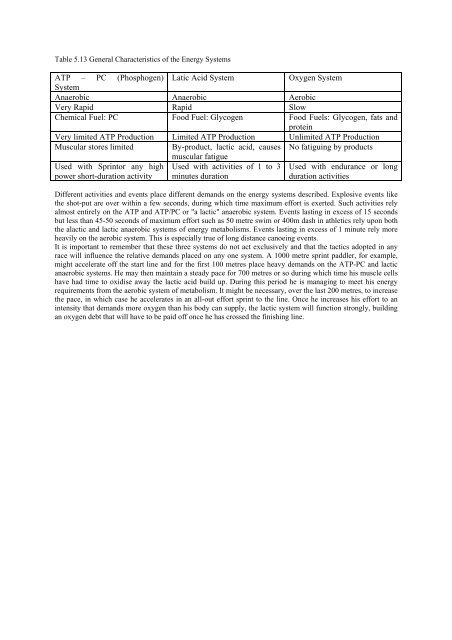The Science of Canoeing By Richard Cox
The Science of Canoeing By Richard Cox
The Science of Canoeing By Richard Cox
Create successful ePaper yourself
Turn your PDF publications into a flip-book with our unique Google optimized e-Paper software.
Table 5.13 General Characteristics <strong>of</strong> the Energy Systems<br />
ATP – PC (Phosphogen) Latic Acid System Oxygen System<br />
System<br />
Anaerobic Anaerobic Aerobic<br />
Very Rapid Rapid Slow<br />
Chemical Fuel: PC Food Fuel: Glycogen Food Fuels: Glycogen, fats and<br />
protein<br />
Very limited ATP Production Limited ATP Production Unlimited ATP Production<br />
Muscular stores limited <strong>By</strong>-product, lactic acid, causes<br />
muscular fatigue<br />
No fatiguing by products<br />
Used with Sprintor any high Used with activities <strong>of</strong> 1 to 3 Used with endurance or long<br />
power short-duration activity minutes duration<br />
duration activities<br />
Different activities and events place different demands on the energy systems described. Explosive events like<br />
the shot-put are over within a few seconds, during which time maximum effort is exerted. Such activities rely<br />
almost entirely on the ATP and ATP/PC or "a lactic" anaerobic system. Events lasting in excess <strong>of</strong> 15 seconds<br />
but less than 45-50 seconds <strong>of</strong> maximum effort such as 50 metre swim or 400m dash in athletics rely upon both<br />
the alactic and lactic anaerobic systems <strong>of</strong> energy metabolisms. Events lasting in excess <strong>of</strong> 1 minute rely more<br />
heavily on the aerobic system. This is especially true <strong>of</strong> long distance canoeing events.<br />
It is important to remember that these three systems do not act exclusively and that the tactics adopted in any<br />
race will influence the relative demands placed on any one system. A 1000 metre sprint paddler, for example,<br />
might accelerate <strong>of</strong>f the start line and for the first 100 metres place heavy demands on the ATP-PC and lactic<br />
anaerobic systems. He may then maintain a steady pace for 700 metres or so during which time his muscle cells<br />
have had time to oxidise away the lactic acid build up. During this period he is managing to meet his energy<br />
requirements from the aerobic system <strong>of</strong> metabolism. It might be necessary, over the last 200 metres, to increase<br />
the pace, in which case he accelerates in an all-out effort sprint to the line. Once he increases his effort to an<br />
intensity that demands more oxygen than his body can supply, the lactic system will function strongly, building<br />
an oxygen debt that will have to be paid <strong>of</strong>f once he has crossed the finishing line.



